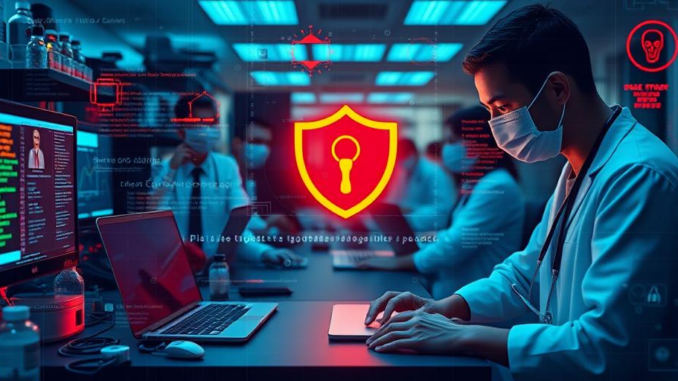
Summary
This article explores the increasing threat of cyberattacks, especially data breaches and ransomware, targeting UK healthcare institutions. It examines the devastating consequences of these attacks, emphasizes the vital role of robust incident response plans, and discusses the broader implications for patient safety and data privacy. The article also delves into specific incidents, highlighting the need for proactive measures and comprehensive cybersecurity strategies.
Safeguard patient information with TrueNASs self-healing data technology.
Main Story
The UK’s National Health Service (NHS), along with other healthcare providers, is under siege. A growing wave of cyberattacks, specifically data breaches and ransomware, is causing real headaches. These aren’t just theoretical problems; they pose significant risks to patient care, data privacy, and the stability of hospital operations.
The Devastating Impact – It’s Real
Think about it. A cyberattack can cripple a hospital. Procedures get delayed, patient data is exposed, and public trust? It plummets. I remember reading about one ransomware attack where a hospital had to postpone surgeries for days. They even had to divert ambulances. Can you imagine the chaos?
Ransomware, in particular, can just decimate entire systems. Hospitals are forced back to manual processes, which is a huge step backwards. Data breaches, on the other hand, expose everything – medical records, financial info, you name it. This can lead to identity theft, fraud, and honestly, a whole lot of stress for patients.
Then there’s the money. Cyberattacks cost a fortune. You’ve got ransom payments, recovery costs, legal fees, regulatory fines, all adding up. But honestly, the reputational damage? That can be even worse. How do you regain public confidence after that?
Incident Response Plans: Your Lifeline
A solid incident response plan is absolutely essential, if you ask me. It’s your roadmap for dealing with these attacks. You need clear procedures for identifying, containing, and getting rid of threats, plus a plan for restoring systems and keeping everyone informed. To break it down:
- Preparation: Regular risk assessments are key. You need to know where your vulnerabilities are. Also, clear protocols and staff training – gotta keep everyone in the loop on cybersecurity best practices, right?
- Detection and Analysis: You need robust monitoring systems. Spotting suspicious activity early is crucial. The faster you analyze potential threats, the better.
- Containment and Eradication: Isolate the affected systems ASAP. Don’t let it spread. Then, get rid of the malware or whatever malicious code snuck in. Fast!
- Recovery: Restore from backups – fingers crossed you have good backups! Make sure the data is still good and get everything back to normal as quickly as you can.
- Post-Incident Activity: This is where you learn. What went wrong? How can you prevent it from happening again? Update your incident response plan accordingly, and yeah, think about your public relations strategy too. You don’t want the whole thing getting blown out of proportion.
Recent Incidents: A Wake-Up Call
Recent attacks on hospitals – Adler Hey Children’s Hospital, Liverpool Heart and Chest Hospital, and Wirral University Teaching Hospital, for example – have really shown how vulnerable the NHS is. It’s not just a theoretical risk, it’s really happening. They have highlighted the need for improved cybersecurity across the board. Better staff training, updated systems, the works, and really robust incident response planning.
Patient Safety & Data Privacy: The Bottom Line
Honestly, the biggest worry is what all this means for patient safety and data privacy. Compromised systems can lead to treatment delays, medication errors, all sorts of bad stuff. And data breaches? Well, that’s a privacy nightmare waiting to happen, it can lead to identity theft, financial fraud, you name it.
Moving Forward: Be Proactive
So, how do we fix this? UK healthcare institutions need to get proactive. That means:
- Investing in Robust Infrastructure: Firewalls, intrusion detection systems, endpoint protection – you need the right tools.
- Prioritizing Staff Training: Educate your people! Make sure they know how to spot phishing scams, manage passwords, and avoid social engineering tactics. It is essential to give them regular refreshers.
- Testing Incident Response Plans: Don’t just write a plan and leave it on a shelf. Test it! Run drills. Find the gaps and fix them.
- Collaborating and Sharing: Share threat intelligence and best practices with other providers, government agencies, and cybersecurity experts. We’re all in this together, so we can help each other. I think that’s pretty obvious.
- Implementing Multi-Factor Authentication: MFA for everyone. No exceptions. It’s an extra layer of security that’s definitely worth the hassle.
By taking these steps, UK healthcare institutions can really boost their defenses. They can protect sensitive patient data and maintain public trust, which, let’s face it, is crucial. The cyber threat landscape is constantly changing, so we need to be vigilant and always ready to adapt. We’ve really got no other choice, do we?


The article highlights the crucial role of incident response plans. Beyond the technical aspects of these plans, how can healthcare institutions ensure effective communication and coordination with external stakeholders, such as law enforcement and regulatory bodies, during a cyber incident?
That’s a great point! Effective communication with external stakeholders is key. Regular joint exercises involving healthcare staff, law enforcement, and regulatory bodies could help build those crucial relationships and streamline coordination during a real incident. It would allow people to understand their roles better.
Editor: MedTechNews.Uk
Thank you to our Sponsor Esdebe
The piece emphasizes staff training in cybersecurity. How can healthcare institutions effectively measure the long-term impact and retention of cybersecurity training among staff, beyond initial assessments?
That’s a really important question! Beyond initial assessments, perhaps ongoing simulated phishing exercises and regular knowledge refreshers could help gauge long-term retention. Also, tracking the number of reported security incidents *before* and *after* training could offer valuable insights. What are your thoughts?
Editor: MedTechNews.Uk
Thank you to our Sponsor Esdebe